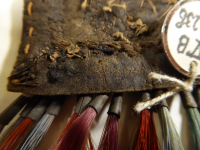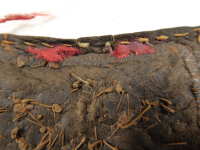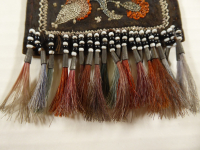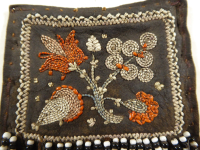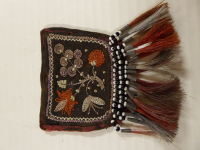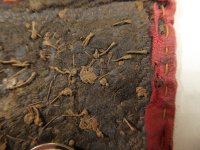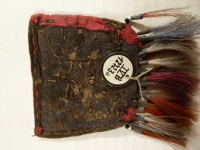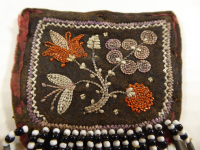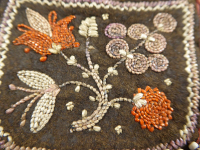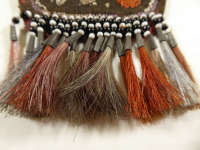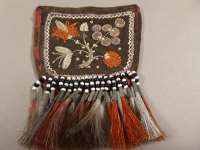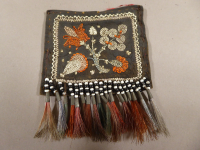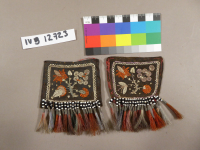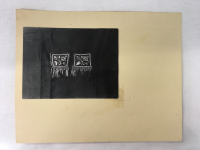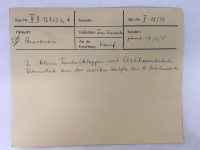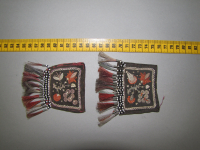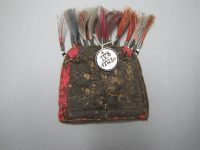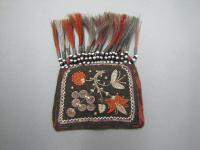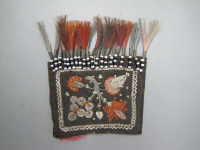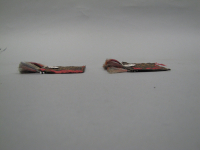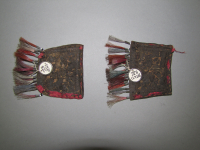patches, pair
patches, pair
patches, pair
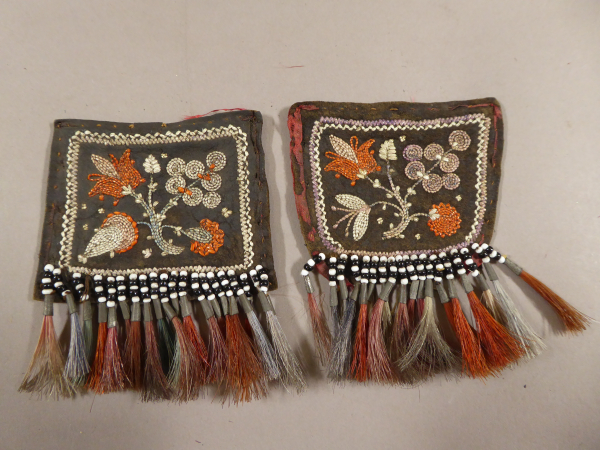
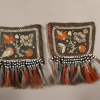
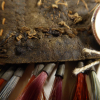
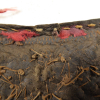
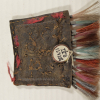
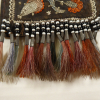
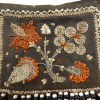
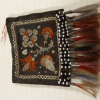


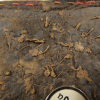
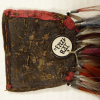

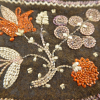
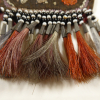
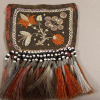
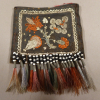

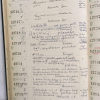
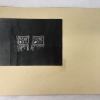

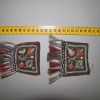
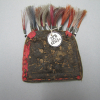
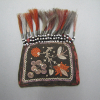

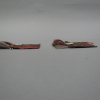
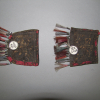
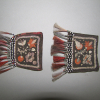
This set or pair of black smoked hide patches is adorned with fine quill, moosehair embroidery, or both. The bottoms of these relatives are edged with black and white beads ending in tiny tinkle cones and dyed moose or deer hair. The hair has been dyed both red and blue, though these have faded over time at different rates. There are remnants of red silk binding on both patches. Patches such as these were made in huge quantities by Wendat and Algonquin women. They made them in sets, which were then sewn onto coats or onto wall pockets. The very fine workmanship on these patches suggest a date of late 18th to early 19th century. These patches were made by a Wendat woman.
These patches currently reside at the Ethnologisches Museum Berlin, Germany.
Wendat, Huron-Wendat
Museum documentation records these as Huron ("Huronen"); Alan Corbiere supported this identification during a GRASAC research visit.
Museum documentation and GRASAC researcher notes
Read More About This Relative
hide; silk ribbon; beads; quill and/or moose hair; deer hair(?); tinkle cones
Black smoked hide; embroidery with moosehair and/or quill
Floral designs including round or globular flowers, petaled flowers, and pom-pom shaped flowers on stems. One patch seems to show two of the flowers in fuller bloom than on the other patch.
When examining the embroidery, GRASAC researchers noted that some of the stitching was shiny, suggesting quill embroidery. They also observed that some of the embroidery was very fine, and that these very small threads could be moosehair. Laura Peers shared research from the Object Lives project, in which they encountered alot of patches such as these. As Laura Peers noted, Huron Wendat and Algonquin women produced an "astonishing amount" of patches - tens of thousands of them. The women created domestic factories, producing these batches. Laura Peers observed that these patches are very nicely made, and are typical of the kinds of patches made.
The patches were sewn onto coats.
On March 15, 2024 Cara Krmpotich identified a strong similarity between these patches and two of four patches on a pair of moose feet wall pockets at the Museum Volkenkunde, Leiden, Netherlands (catalogue number 494-11) (GRASAC GKS ID 24952). See the patches on the top right and bottom left in the images. These are linked as Related Items.
Laura Peers suggested the time frame of late 18th to early 19th century based on research involving patches such as these, and the fineness of the work on these particular patches.
Provenance
Museum records state that these were purchased from Frau Konietzko in 1959. Other items were purchased from her at the same time.
Other Catalogue Identifiers: file no.: V 18/59
Museum documentation
Object Lives website: http://objectlives.com/
Lemire, Beverly, Laura Peers and Anne Whitelaw (editors). "Object Lives and Global Histories in Northern North America: Material Culture in Motion c. 1780-1980." Montreal & Kingston: McGill-Queen's University Press.
About This GRASAC Record
Wendat Maker, Name Unknown. Patches, pair. GRASAC ID 59171. Ethnologisches Museum Berlin, Catalogue Number IV-B-12723 A B.
Created by Nikolaus Stolle during a research visit to the museum commissioned by Ruth Phillips and supported by her research funds. This record was augmented by Cara Krmpotich on March 14, 2024 using photographs and notes created during a GRASAC research visit to the Museum in May 2019. The GRASAC team included Cara Krmpotich, Alan Corbiere, Laura Peers, Maureen Matthews and Hannah Turner and Charles Feaver on photography. Curator Monika Zessnik supported the team throughout the visit.
Cara Krmpotich realized there are duplicate records for these patches - the information from both records has been combined here. The previous GKS Record ID was 24535 - it has been archived.













The owner indicated Georgian Bay as the origin for these patches. It is unclear where on the land these came from, so the pin marker on the map reflects the Bay as a whole.
 Knowledge Sharing Platform
Knowledge Sharing Platform


